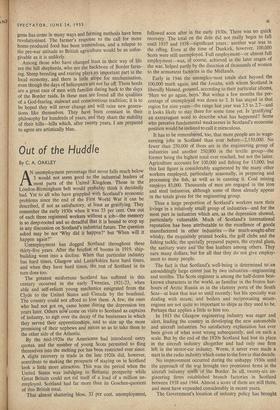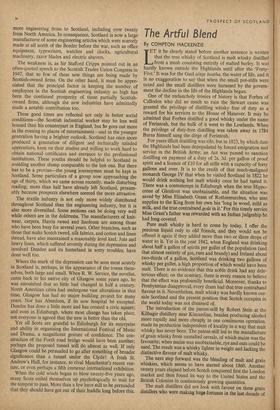Out of the Huddle
By C. A. OAKLEY AN unemployment percentage that never falls much below 3 would not seem good to the industrial leaders of most parts of the United Kingdom. Those in the London-Birmingham belt would probably think it decidedly bad. Yet to all who have grappled with Scotland's economic problems since the end of the First World War if can be described, if not as satisfactory, at least as gratifying. They remember the early 1930s when it was 33 per cent. One out of each three registered workers without a job-,L-the memory is so deep-rooted and so dreadful that it is bound to crop up in any discussion on Scotland's industrial future. The question asked may be not 'Why did it happen?' but 'When will it happen again?'
Unemployment has dogged Scotland throughout these thirty-five years. After the briefest of booms in 1919, ship- building went into a decline. When that particular industry has hard times, Glasgow and Lanarkshire have hard times, and when they have hard times, the rest of Scotland in its turn does too.
The greatest misfortune Scotland has suffered in this century occurred in the early Twenties, 1921-23, when able and self-reliant young mechanics emigrated from the Clyde to the United States and Canada by the boatload. The country could not afford to lose them. A few, the ones who had not got on, came home during the depression ten years later. Others now comeon visits to Scotland as captains of industry, to sigh over the decay of the businesses in which they served their apprenticeships, and to size up the more promising of their nephews and nieces so as to take them to the other side of the Atlantic.
By the mid-1920s the Americans had introduced entry quotas, and the number of young Scots permitted to fling themselves into the melting pot has been restricted ever since. A slight recovery in trade in the late 1920s did, however, contribute to making the prospects of staying on in Scotland look a little more attractive. This was the period when the United States was indulging in fantastic prosperity while Great Britain could not rid itself of a load of a million un- employed. Scdtland had far more than its Goschen-quotient of this British total.
That almost shattering blow, 33 per cent. unemployment, followed soon after in the early 1930s. There was no quick recovery. The total on the dole did not really begin to fall until 1937 and 1938—significant years : another war was in the offing. Even at the time of Dunkirk, however, 100,000 Scots were still unemployed. Full employment—or almost full employment—was, of course, achieved in the later stages, of the war, helped partly by the direction of thousands of women to the armament factories in the Midlands.
Early in 1946 the unemployment totals shot beyond the 100,000 mark again, and the Jonah% with whom Scotland is liberally blessed, groaned. according to their particular idioms, 'Here we go again, boys.' But within a few months the per- centage of unemployed was down to' 3. It has stayed in that region for nine years—the range last year was 3.5 to 2.7—and it looks likely to stay there for some time yet. Is 'gratifying' an extravagant word to describe what has happened? Some who perceive fundamental weaknesses in Scotland's economic position would be inclined to call it miraculous.
It has to be remembered, too, that more people are in wage- earning jobs in Scotland than ever before-2,150,000. No fewer than 250,000 of them are in the engineering group of industries and another 250,000 in the textile group—the former being the highest total ever reached, but not the latter. Agriculture accounts for 100,000 and fishing for 13,000, but this last figure is considerably augmented by the many other workers employed, particularly seasonally, in preparing and processing the fish, as well as in canning it. Coal mining employs 83.000. Thousands of men are engaged in the iron and steel industries, although some of them already appear in the totals given for the engineering group.
Thus a large proportion of Scotland's workers earn their livings in a relatively small group of industries—and for the most part in industries which are, as the depression showed, particularly vulnerable. Much of Scotland's international reputation has been attributable to the excellence of goods manufactured in other industries — the much-sought-after whisky, the exquisitely printed books, the golf clubs and the fishing tackle, the specially prepared papers, the crystal glass, the sanitary ware and the fine leathers among others. They earn many dollars, but for all that they do not give employ- ment to many people.
The fact is that Scotland's well-being is determined to an astonishingly large extent just by two industries—engineering and textiles. The Scots engineer is among the half-dozen best- known characters in the world, as familiar in the frozen har- bours of Arctic Russia as in the clammy ports of the South Seas—at least that was so until recently; but his specialty was dealing with steam; and boilers and reciprocating steam-, engines are not quite so important to ships as they used to be. Perhaps that applies a little to him too.
In 1913 the Glasgow engineering industry was eager and alert, leading the country in developing the new automobile and aircraft industries. No satisfactory explanation has ever been given of what went wrong subsequently, and on such a scale. But by the end of the 1920s Scotland had lost its place in the aircraft industry altogether and had only one firm left in the motor-car industry. Worse, it never even made a start in the radio industry which came to the fore in that decade.
No improvement occurred during the unhappy 1930s until the approach of the war brought two prominent firms in the aircraft industry nor& of the Border. In all, twenty-six en- gineering firms established branch factories in Scotland between 1938 and 1944. Almost a score of them are still there, and most have expanded considerably in recent years. The. Government's location of industry policy has brought more engineering firms to Scotland, including over twenty from North America. In consequence, Scotland is now a large manufacturer of some engineering articles which were scarcely made at all north of the Border before the war, such as office equipment, typewriters, watches and clocks, agricultural machinery, razor blades and electric shavers.
The weakness is, as Sir Stafford Cripps pointed out in an often-quoted speech to the Scottish Trades Union Congress in 1947. that so few of these new things are being made by Scottish-owned firms. On the other hand, it must be appre- ciated that the principal factor in keeping the number of employees in the Scottish engineering industry so high has been the continued prosperity of these partially Scottish- owned firms, although the new industries have admittedly made a notable contribution too.
These good times are reflected not only in better social conditions—the Scottish industrial worker may be less well housed than his counterpart in England, but he goes out more in the evening to places of entertainment—and in the younger generation having a brighter outlook. Scotland has once more produced a generation of diligent and technically minded apprentices, keen on their studies and willing to work hard to obtain national certificates and entrance to the professional institutions. These youths should be helpful to Scotland in avoiding another slump comparable to the last one. But there has to be a proviso—the young journeymen must be kept in Scotland. Some particulars of a group now approaching the age of thirty. which we came across recently, made disturbing reading; more than half have already left Scotland, presum- ably because prospects elsewhere seemed the more attractive.
The textile industry is not only more widely distributed throughout Scotland than the engineering industry, but it is also more diversified. Some sections can be doing very well while others are in the doldrums. The manufacturers of knit- wear, carpets, Harris tweed and linoleum are among those who have been busy for several years. Other branches, such as those that make Scotch tweed, silk fabrics, and cotton and linen thread, have also maintained a reasonably level keel. Jute and heavy linen, which suffered severely during the depression and involved Dundee and its hinterland in sorry troubles, have done well too.
Where the mark of the depression can be seen most acutely in Scotland is, perhaps, in the appearance of the towns them- selves, both large and small. When R. W. Service, the novelist, came back to his native city of Glasgow some years ago, he was astonished that so little had changed in half a century. North American cities had undergone vast alterations in that time. Glasgow has had no major building project for many years. Nor has Aberdeen, if its new hospital be excepted. Dundee has done a little more and has created a civic square; and even in Edinburgh, where most change has taken place, not everyone is agreed that the new is better than the old.
Yet all Scots are grateful to Edinburgh for its enterprise and ability in organising the International Festival of Music and Drama, a magnificent gesture of confidence. The con- struction of the Forth road bridge would have been another; perhaps the proposed tunnel will do almost as well. If only Glasgow could be persuaded to go after something of broader significance than a tunnel under the Clyde! A fresh St. Andrew's Hall, for instance, to rival Manchester's recent ven- ture, or even perhaps a fifth immense international exhibition.
When the cold winds began to blow twenty-five years ago, many Scots coiled themselves up psychologically to wait for the tempest to pass. More than a few have still to be persuaded that they should have got out of their huddle long before this.


















































 Previous page
Previous page